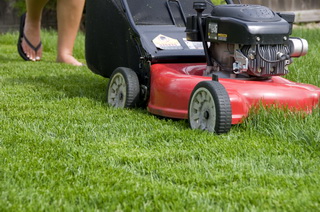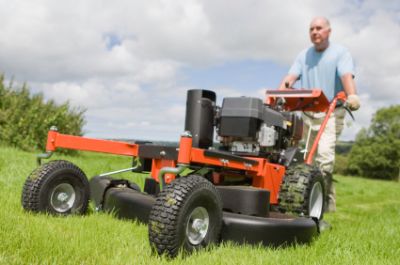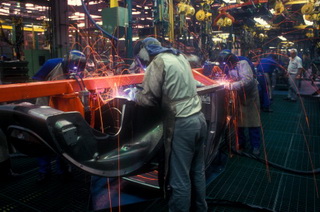
With Deadman Controls on Walk-Behind Power Lawn Mowers –
Why are Accidents Still Occurring?
On the Scene E-Newsletter, Edition 135, March 28, 2011
 With Spring around the corner, companies and individuals begin to prepare their lawnmowers for the new season. Once the grass cutting begins, unfortunately, it becomes the season for lawnmower injuries.
With Spring around the corner, companies and individuals begin to prepare their lawnmowers for the new season. Once the grass cutting begins, unfortunately, it becomes the season for lawnmower injuries.
Lawnmowers today are built with many safety features intended to prevent accidents. The safety features for walk-behind mowers are required by federal code (16 CFR 1205). Most notable are the guards around the mower deck to prevent foot injuries and some form of blade control.
Blade control takes one of two forms. The simplest is a device known as a dead man switch that requires the operator to hold a lever down from the operator position to keep the engine running. The disadvantage to this control is that every time the operator steps away from behind the mower, like to empty the grass catcher, he or she has to re-start the mower.
An alternative provided as an option by many manufacturers is blade brake control which uses a clutch/brake combination to stop the blade from spinning while the engine continues to run. The requirement for either of these safety devices is to bring the blade to a stop from full speed within three seconds when the control is released.
There is no such thing as a foolproof dead man control for lawnmowers. Many users bypass the protection by tying down the safety handle so they don’t have to hold it. When the safety device is defeated, an individual can empty the grass catcher, clear the discharge chute and perform under deck cleaning with the engine running and the blade spinning, even though these are clearly unsafe practices.
The requirement related to guarding is that contact be prevented between the feet of the operator and the rotating blade. On most mowers, this is a combination of the fixed mower deck and a flexible guard that extends down to the grass level. The misuse of guarding is when users either remove or neglect to replace the foot shields. When this happens, the operator can accidently pull the mower over their toes or their foot can slip into the mower as they pull it backward up a hill.
Since these safety requirements have been around for a generation, most accidents today are caused because operators bypass the safety devices or because they are rushed, distracted or exhibit careless behavior. A lawnmower cannot distinguish between a blade of grass, a twig, a finger or a foot; therefore, the user must think before acting and stay away from moving parts. However, there will always be individuals who act before they think.
Lawnmower operators need to remember the basic safety rules:
1. Read the manual before operating the lawnmower.
2. Wear appropriate footwear (no open-toed shoes) and eye protection when moving.
3. Leave all safety features intact (blade brake control or dead man control, guards, shield, deflectors and warning decals).
4. Replace safety features that fail or wear out.
5. Clear the mowing area of all debris before mowing.
6. Avoid any contact with the blade. Never clear the chute or put your hand near the blade while the lawnmower is running.
7. When using a push mower on steep slopes, mow across the slope to avoid slippage and foot injuries.
8. Keep children and pets at a safe distance away while mowing.
Even with the lawnmower safety features and safe practices discussed above, CED receives calls to investigate these preventable accidents. Every year, we continue to work on cases where individuals break safety rules and injuries result. Our engineers possess the expertise and safety knowledge to investigate accidents involving lawnmowers, locomotives, freight elevators, snow-blowers, treadmills, snowmobiles, personal watercraft, forklift trucks, and hand tools as well as many other products/machines. To discuss a case, please call us at (800) 780-4221 – or via E-mail at casemanager@cedtechnologies.com.






